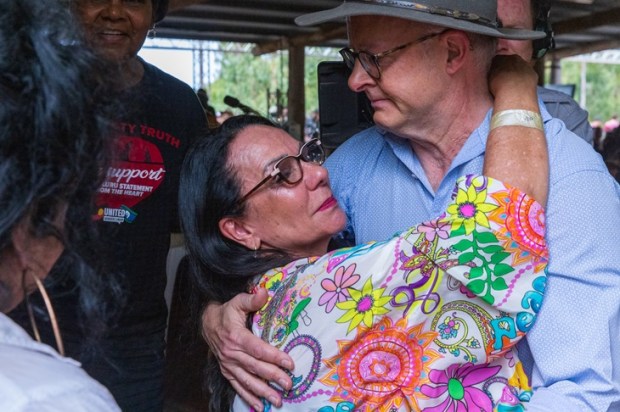It’s a bit rich for Julia Baird and Hayley Gleeson, having spent the previous twelve months conducting a special ‘investigation’ into how the six major religions in Australia—Islam, evangelical Christianity, Catholicism, Sikhism, Hinduism and Judaism—are complicit in cultivating a culture domestic violence against their female members, to all of a sudden present themselves as the defenders, and even champions, of religious belief. But in their latest article, that’s precisely what they have done.
Baird and Gleeson have suddenly taken the high moral ground against those who, in response to their extensive reporting, think that when it comes to domestic violence, it’s religion itself which is primarily to blame—now, where could they possibly have got that idea from? They have even had the audacity to sanctimoniously scold their unbelieving readers that, “victim blaming doesn’t help.”
By the way, Baird and Gleeson have published a subsequent article stating that “One in four churchgoers [are] in abusive relationships.” Although see the devastating critique by Andrew Bolt, who points out that the sample of 438 people from Cumbria in the UK were “entirely self-selected” with “…nearly half the Christians who claimed to have been abused by their partner… living with a non-Christian.” Hardly what you would refer to as a legitimate and unbiased sample.
But the fundamental problem, according to Baird and Gleeson, is not with religion in general, it’s with men in particular. Or to put it more precisely, their institutionally enshrined ‘white privilege’ of patriarchy. As they state:
As experts we interviewed have repeatedly pointed out, domestic abuse is found through our society and flourishes in cultures where women are excluded.
And this is patriarchy, which, as our reporting has demonstrated, has deep roots in institutional religion.
Baird and Gleeson claim to have “interviewed hundreds of survivors, social workers, counsellors, clergy, theologians and social workers.” But while in a postmodern world it is virtually impossible to challenge or disagree with any individual’s “personal story”, the sociological evidence just doesn’t support their thesis.
For a start, Dr Steven Tracey, the sole academic source which they quoted to back up their original claims, actually argues against Baird and Gleeson’s position. In fact, in an article for Christianity Today, titled “Headship with Heart, Tracey unequivocally states that “biblical patriarchy prevents abuse.”
Baird’s only response to those who challenged her—such as Dr Augusto Zimmerman in Quadrant, or Dr Mark Durie in The Spectator—was that we shouldn’t “quibble about footnotes”. And then she doubled down on this claim saying:
By the way, any dispute about that… I am completely comfortable with the competence of that research… 2004 by Bradford Wilcox… 2007 (and 2008) by Steven Tracey.
Well, we’ve already seen that Dr Tracey refutes her overarching position. But rather embarrassingly for Baird, Dr Bradford Wilcox subsequently wrote an opinion piece for The Australian titled, “Facts go missing in ABC report on ‘violent Christians’. Clearly, Dr Wilcox didn’t think that Baird and Gleeson were accurately reflecting upon the scientific conclusions that he reached in his research. In fact, back in August of 2017, I wrote this:
The most significant piece of sociological research on the issue though is Wilcox’s Soft Patriarchs, New Men. After analysing all of the data, he concludes as follows:
These findings paint a striking picture…Contrary to the assertions of feminists, many family scholars, and public critics, these men cannot be fairly described as “abusive” and “authoritarian” family men wedded to “stereotypical forms of masculinity.” They outpace mainline Protestant [egalitarian] and unaffiliated family men in their emotional and practical dedication to their children and wives and in their commitment to familism [a family-centred spirituality], and they are the least likely to physically abuse their wives.
However, Baird and Gleeson’s entire thesis in explaining domestic violence (DV) can be demonstrated to be false with the following case study based on the research by Matthew Ball and Sharon Hayes (2009). Same-sex intimate partner violence: Exploring the parameters. In B. Scherer (Ed.) Queering Paradigms (New York: Peter Lang): pages 161-177.
You see, according to the Australian Government’s website, over 40 per cent of homosexual men and almost 30 per cent of lesbians have experienced DV within a same-sex intimate partner relationship. What’s more, according to the LGBTIQ community itself, this “is twice the rate for men and almost three times that for women, respectively, with a history of only opposite-sex cohabitation.”
Officially the Australian government’s website declares that rates of DV are the same between the two groups. However, they also go on to say that there are no less than fifteen(!) different reasons as to why DV within the LGBTIQ community is being under-reported.
Hence, not only is the traditional feminist framework for DV simplistic, but it’s also inaccurate and naïve. Why? Well, the nature of DV within the LGBTIQ community involves complex notions of power. Not only that, but DV between same-sex couples is, more often than not, mutual rather than being perpetrated by just one of the partners.
What’s more, the outworking of the abuse may have nothing to do with physical violence at all—although tragically, in LGBTIQ relationships that does still also occur—but instead involves emotional, financial, and especially sexual control. Hence, as the Australian Government’s website concludes:
Concepts such as ‘intimate terrorism’ and ‘coercive control’ are thought to be useful for defining intimate partner violence in LGBTIQ populations as these definitions emphasise that intimate partner violence is primarily defined by patterns of coercion, power and control.
So, you see, a traditional feminist discourse completely falls apart when you’re dealing with those who are in a same-sex relationship. Let’s face it, if you’re a lesbian then there’s obviously no man around to blame, and if you’re a gay man then you can’t both be at fault, can you?!
What’s more, as Andrew Bolt also points against Baird and Gleeson’s spurious reporting, it is patently untrue to claim that evangelical Protestant men who attend church, even “sporadically”, are the most likely to beat their wives. Instead, it involves a culture that has women in positions of cultural power and authority where they are recognised as “elders”. As Bolt notes:
The most likely wife-bashers are Aboriginal men, with Aboriginal women at least 31 times more likely to be hospitalised.
All of which is to say, Baird and Gleeson really need to know the Australian community at a deeper level and present solid and valid research. Frankly, Julia Baird’s biased research in this area casts a shadow over all the so-called ‘scholarly’ research in which she has been engaged in on social and historical issues.
Furthermore, both Baird and Gleeson should interview people in the LGBTIQ or indigenous community where a different philosophical framework to their own is obviously needed in understanding the causes of DV. Or at the very least, they must stop pretending that they are protecting the religious institutions they have been complicit in denigrating and tearing down.
Mark Powell is the Associate Pastor of Cornerstone Presbyterian Church, Strathfield.
Illustration: ABC publicity.
Got something to add? Join the discussion and comment below.
Got something to add? Join the discussion and comment below.
Get 10 issues for just $10
Subscribe to The Spectator Australia today for the next 10 magazine issues, plus full online access, for just $10.


























Comments
Don't miss out
Join the conversation with other Spectator Australia readers. Subscribe to leave a comment.
SUBSCRIBEAlready a subscriber? Log in